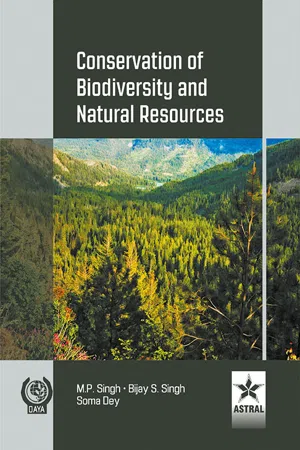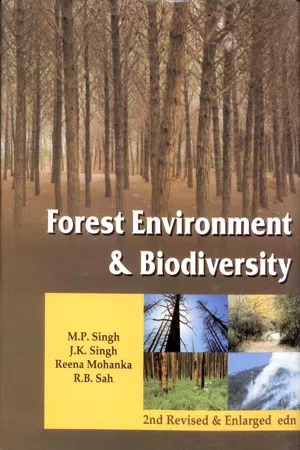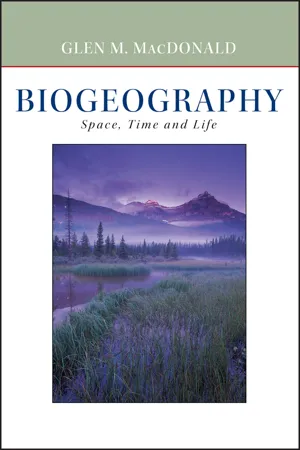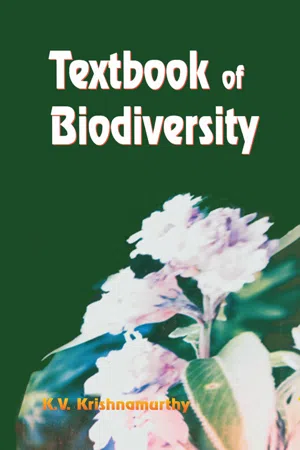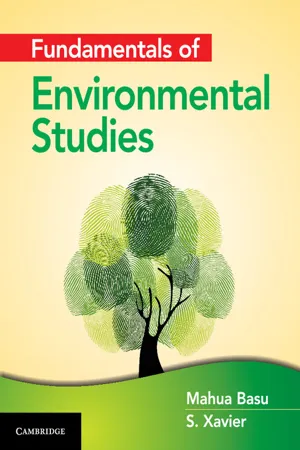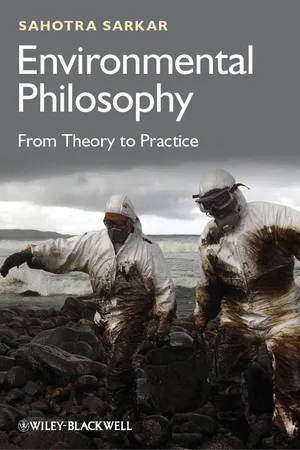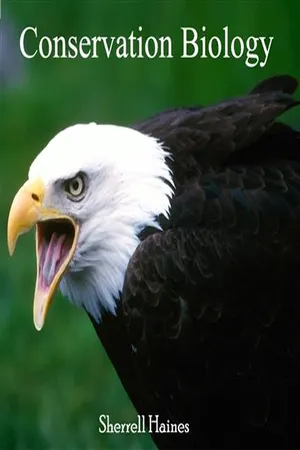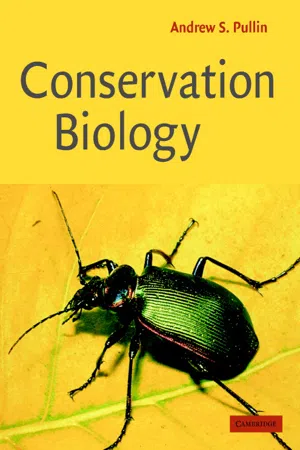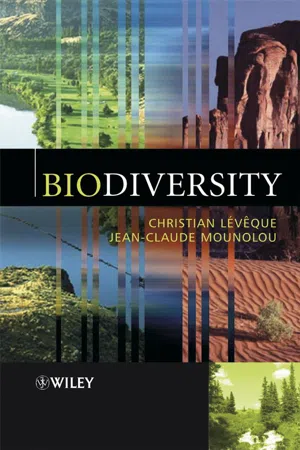Geography
Biodiversity Conservation
Biodiversity conservation refers to the protection, management, and restoration of the variety of life on Earth, including ecosystems, species, and genetic diversity. It aims to maintain the balance of natural systems and ensure the sustainable use of resources for future generations. Conservation efforts often involve the establishment of protected areas, habitat restoration, and sustainable resource management practices.
Written by Perlego with AI-assistance
Related key terms
1 of 5
12 Key excerpts on "Biodiversity Conservation"
- Singh, M P, Soma Dey(Authors)
- 2021(Publication Date)
- Daya Publishing House(Publisher)
5 Conservation of Biodiversity Introduction The conservation of biological diversity constitutes an essential aspect of sustainable development worldwide. It is biodiversity that basically determines the structure and function of all ecosystems (see Hawkes, 1991). It is the foundation on which the future well-being of human society rests. It has a powerful role in building sustainable human societies. Unfortunately, many countries having the largest concentrations of biological diversity are also characterized by persistent poverty and high rates of population growth; both these factors work against conservation as they increase the pressure for inappropriate and harmful land-use, and limit the ability of individuals and governments to halt the loss of diversity. In most tropical countries, conservation efforts have been largely influenced by foreign agencies. The traditional conservation model followed by industrial countries and adopted by many developing countries emphasizes custodial management, such as parks and reserves, that ban most human activities within their boundaries. Protected areas have been set aside to preserve the so-called charismatic species (e.g., elephants, tigers, or bears), spectacular vistas or geologic formations, and recreational or historic sites. Some areas have also been reserved for protecting watersheds or reserving timber supplies. Until recently, however, few areas were established expressly for conserving biological diversity (Anonymous, 1994). Many species hybridize sometimes and reproductive isolation is often incomplete. This is true of both animals and plants, even those with elaborate ‘reproductive isolating mechanisms’. Occasional hybridization, even leading to gene flow, does not necessarily vilate a species’ integrity.- Singh, M P(Authors)
- 2021(Publication Date)
- Daya Publishing House(Publisher)
Chapter 27 Conservation of Biodiversity Introduction The conservation of biological diversity constitutes an essential aspect of sustainable development worldwide. It is biodiversity that basically determines the structure and function of all ecosystems (see Hawkes, 1991). It is the foundation on which the future well-being of human society rests. It has a powerful role in building sustainable human societies. Unfortunately, many countries having the largest concentrations of biological diversity are also characterized by persistent poverty and high rates of population growth; both these factors work against conservation as they increase the pressure for inappropriate and harmful land-use, and limit the ability of individuals and governments to halt the loss of diversity. In most tropical countries, conservation efforts have been largely influenced by foreign agencies. The traditional conservation model followed by industrial countries and adopted by many developing countries emphasizes custodial management, such as parks and reserves, that ban most human activities within their boundaries. Protected areas have been set aside to preserve the so-called charismatic species ( e.g. , elephants, tigers, or bears), spectacular vistas or geologic formations, and recreational or historic sites. Some areas have also been reserved for protecting watersheds or reserving timber supplies. Until recently, however, few areas were established expressly for conserving biological diversity (Anonymous, 1994). Many species hybridize sometimes and reproductive isolation is often incomplete. This is true of both animals and plants, even those with elaborate This ebook is exclusively for this university only. Cannot be resold/distributed. ‘reproductive isolating mechanisms’. Occasional hybridization, even leading to gene flow, does not necessarily vilate a species’ integrity.- eBook - PDF
Biogeography
Introduction to Space, Time, and Life
- Glen MacDonald(Author)
- 2015(Publication Date)
- Wiley(Publisher)
We have seen that geography and history have worked together to produce the incredibly complex and beautiful modern biosphere that we are a part of. We have also learned that humans have played a lamentable role in the extinction of a great many species. In this final chapter, we have observed that we face many challenges in preserving the remaining biodiversity and natural habitats of the world. Our efforts must take on a spe- cial urgency because as human population grows, the rate of habitat and species loss also increases. The specter of global warming means that no species or environment can be counted on as completely secure in the years ahead. We have seen how the study of biogeography and allied fields can help us to both understand and preserve the natural life of the planet. The application of bio- geography for conservation is still in an early stage, and many exciting discov- eries lie ahead. Perhaps for some of you this book will start you on the road to learning more about biogeography, ecology, paleontology, and the other life and earth sciences. You may actually take up the challenge of working as bio- geographers to understand and protect the biosphere. If so, this book has been more than successful. For others, I will consider this book successful if a trip through a national park or even a simple walk through autumn leaves is just a little more enjoyable because you are now more aware of how you, and all the plants and animals you encounter, are part of the marvelous and continuing story of space, time, and life. - eBook - PDF
- K V Krishnamurthy(Author)
- 2003(Publication Date)
- CRC Press(Publisher)
Biodiversity Conservationhas thus been changed from an idealistic philosophy to a very serious technology. Conservation biology has also become a very challenging discipline in that it has 'to counter by human forces all that humans themselves have been responsible for'. Current Practice in Conservation Conservation of biodiversity can be attempted at three levels: Genes, Species and Ecosystems. As we have already seen in the first chapter of this book, the three constitute different levels of biological organisation and are interlinked. Maintenance of ecosystem diversity implies conservation of species which constitute that ecosystem, although it is feasible to conserve a species independent of the ecosystem of which it is a normal component. Maintenance of genetic diversity within a species implies maintenance of that species. Conservation of species diversity will take care to some extent of both ecosystem maintenance and genetic maintenance and hence many people consider it pivotal to the conservation of biodiversity. Moreover, loss of species diversity is more obvious and quantifiable than genetic or ecosystem diversity loss. Species in danger of loss can thus be readily identified and suitable conservation strategies planned. Conservation strategies based on species maintenance are labelled 'species-based' approaches. Some people, however, lay emphasis on 'Habitat- or ecosystem-based' approaches for conservation. The relative merits and demerits of either approach are discussed below. o ow ever in very recent years certain biodiversity institutions, such as the Botanic Gardens conservation nternational (BGCI), have instructed Botanic Gardens to give emphasis and priority to the ex-situ mnservation of economically important plants that are threatened (see discussion later in this chapter). Conservation of Genetic Diversity It should be emphasised at the very outset that the unit for genetic conservation is a population of a species, i.e. - eBook - PDF
- Mahua Basu, Xavier Savarimuthu, SJ(Authors)
- 2017(Publication Date)
- Cambridge University Press(Publisher)
5 Biodiversity and Its Conservation Learning objectives To understand the various aspects and levels of biodiversity. To know about the various biogeographical regions and enormous wealth of India along with global perspective. To realize and develop a value and appreciation for the biodiversity services we receive. To draw attention towards the threats that biodiversity confronts. To know about scientific biodiversity management strategies. 5.1 Introduction and Concept The primary aims of the Convention of Biodiversity (CBD) are: conserving biodiversity including protection and management; sustainable and viable employment of the constituents of biodiversity; and rational and justifiable benefit distribution that arise out of the utilization of genetic resources. India being a signatory party to the CBD also pursues the same objectives. According to Convention of Biodiversity , CBD , 1992 ‘Biological diversity’ means the variability among living organisms from all sources including, inter alia, terrestrial, marine and other aquatic ecosystems and the ecological complexes of which they are part: this includes diversity within species, between species and of ecosystems’. The term ‘ biological diversity’ was invented by Thomas Lovejoy in 1980 while the word ‘ biodiversity’ was invented by Walter G. Rosen in 1985; however, it appeared for the first time in 1988, in an article by EO Wilson. Diversity can be defined as the total number of diverse objects and their relative frequency in which they occur on earth. In other words, biological diversity refers to the variety (multiplicity) and variability (changeability) among the sum total of all organisms along with the environmental domains in which they usually occur. According to World Resources Institute (WRI), World Conservation Union (WCU), and United Nations Environment Programme (UNEP) , in ‘Global Biodiversity Strategy,’ 1992: ‘ Biodiversity is the totality of genes, species, and ecosystems in a region...’ . - eBook - ePub
Environmental Philosophy
From Theory to Practice
- Sahotra Sarkar(Author)
- 2011(Publication Date)
- Wiley-Blackwell(Publisher)
The term “biodiversity” was only introduced in 1986 as a contraction for “biological diversity.” Many commentators have analyzed the synergistic growth of the use of the term “biodiversity” and the growing popularity of conservation biology as a discipline. Conservation biologists, particularly in the United States, felt that they were creating a brave new science. While this claim has little factual support (nature conservation, including the conservation of large complements of species, has a long history), it led conservation biologists to theorize about “biodiversity” while largely ignoring earlier attempts by ecologists to formulate a quantitative measure of ecological diversity. 2 One consequence of this history is that the best way philosophers have been able to make sense of the concept of biodiversity (which remains problematic when scrutinized carefully, as this chapter will show) is to view it in the context of the emergence of conservation biology: biodiversity is simply the goal pursued by the practice of conservation biology. 3 A wide variety of practices fall under the rubric of conservation biology, which is a hybrid discipline incorporating insights from many areas of biology relevant to the persistence of biota and, arguably, also insights from the social sciences and the humanities (see below). The most relevant area within biology is ecology, which studies the interactions of species and individuals with each other and with the physical environment. The main differences between conservation biology and ecology are that the former embraces many other disciplines (as noted earlier, and emphasized below) and is explicitly a goal-oriented discipline aiming to ensure the persistence of biodiversity into the indefinite future - No longer available |Learn more
- (Author)
- 2014(Publication Date)
- University Publications(Publisher)
Conservation biology is concerned with phenomena that affect the maintenance, loss, and restoration of biodiversity and the science of sustaining evolutionary processes that engender genetic, population, species, and ecosystem diversity. The concern stems from estimates suggesting that up to 50% of all species on the planet will disappear within the next 50 years, which has contributed to poverty, starvation, and will reset the course of evolution on this planet. Conservation biologists research and educate on the trends and process of biodiversity loss, species extinctions, and the negative affect this is having on our capabilities to sustain the well-being of human society. Conservation biologists work in the field and office, in government, universities, non-profit organizations and industry. They are funded to research, monitor, and catalog every angle of the earth and its relation to society. The topics are diverse, because this is an interdisciplinary network with profess-sional alliances in the biological as well as social sciences. Those dedicated to the cause and profession advocate for a global response to the current biodiversity crisis based on morals, ethics, and scientific reason. Organizations and citizens are responding to the biodiversity crisis through conservation action plans that direct research, monitoring, and education programs that engage concerns at local through global scales. Context and trends Conservation biologists study trends and process from the paleontological past to the ecological present as they gain an understanding of the context related to species extin-ction. It is generally accepted that there have been five major global mass extinctions that register in Earth's history. These include: the Ordovician (440 mya), Devonian (370 mya), Permian–Triassic (245 mya), Triassic–Jurassic (200 mya), and Cretaceous (65 mya) extinction spasms. - eBook - PDF
Environment
An Interdisciplinary Anthology
- Eugene Jolas, Andreas Kramer, Rainer Rumold(Authors)
- 2008(Publication Date)
- Yale University Press(Publisher)
Species are becoming endangered and suffering extinc-tion, ecosystems are being degraded, and genetic diversity is diminishing at a historically accelerated rate, mostly as a result of direct or indirect human activ-ity. The discipline that concerns itself with this loss is conservation biology. The term “biodiversity” usually suggests counting species, frequently mea-sured either as the number of different species present in a particular ecosystem, as in the claim that “the tropical rainforest has more biodiversity than any other kind of ecosystem on Earth,” or as the number of species in a larger, more in-clusive taxonomic group, as in the statement that “there is greater biodiversity of insects than mammals.” However, biodiversity is not that simple. Ecosystems can be degraded and ecosystem types can be lost without the extinction or endangerment of any par-ticular species. The loss of diversity of ecosystems themselves must also be con-sidered a loss of biodiversity. Moreover, genetic variability within one species (or population) may be diminished without the immediate loss or endangerment of that species. This too is loss of biodiversity. Thus, biodiversity can be threatened at many different levels. In fact, its most common definition, best phrased by the United States Office of Technology Assessment (OTA), is: Biological diversity refers to the variety and variability among living organ-isms and the ecological complexes in which they occur. Diversity can be de-fined as the number of different items and their relative frequency. For bio-logical diversity, these items are organized at many levels, ranging from complete ecosystems to the chemical structures that are the molecular basis of heredity. Thus, the term encompasses different ecosystems, species, genes, and their relative abundance. 362 Yes, all that and yet more. Biodiversity, in theory and in practice, is even broader than this OTA definition. - eBook - PDF
- Andrew S. Pullin(Author)
- 2002(Publication Date)
- Cambridge University Press(Publisher)
This has had profound implications for our view of maintaining isolated populations in nature reserves (see Chapter 9) and opened up a whole new area of research on landscape scale conserva-tion (see Chapter 12). The Rio Summit and Biodiversity Convention The term biodiversity arose as a shortening of ‘biological diversity’ as mentioned in Chapter 1. It appears to have first been used by Walter G. Rosen in 1985 for the first planning meeting of the US National Forum on Biodiversity held in 1986. This resulted in a proceedings volume enti-tled ‘Biodiversity’ that brought the term into popular use (Wilson & Peters 1988). While the science of conservation biology has been devel-oping, environmental politics has added to the challenges the subject faces by setting agendas for action which should be clearly informed by the science. The rise of environmental issues on the political agenda was reflected in a call for a summit of world leaders to discuss environ-mental problems and agree on actions and targets for sustainable devel-opment. This was manifest in the United Nations Conference on Environment and Development (often referred to as the ‘Rio Summit’ or ‘Earth Summit’) held in Rio de Janeiro, Brazil in 1992. This meeting dis-cussed many broad environmental issues, but for conservation biology the most important aspect was the convention on biodiversity, which requires signatory countries to take action to protect biodiversity and use it sustainably (see below). As a consequence of signing up to this con-vention, many countries have produced their own action plans for both habitats and species. This has simultaneously increased conservation activity and exposed areas of ignorance that require urgent research, such as species about which we know very little but where nevertheless we have to take some action. Unfortunately, governments have been less enthusiastic about providing money for these programmes to be carried out. - eBook - PDF
- Christian Lévêque, Jean-Claude Mounolou(Authors)
- 2004(Publication Date)
- Wiley(Publisher)
The reality is not so positive, since in the absence of legitimate, strong mediators, the imbalance of power still impedes any real progress towards more conscientious conservation and more equit- able benefit-sharing. Once they enter the domain of biodiversity management, the markets for use-rights and intellectual property rights will have a major impact in developing countries. Depending upon how they are regulated, these markets can either strengthen rural communities or else, if these rights are cornered by those parties empowered by the state, tradition or wealth, marginalize them even further. Given the present situation, the latter alternative appears more likely. The future of biodiversity is far from assured, despite the current international dialogue. 266 10 THE CONSERVATION OF BIODIVERSITY A Conclusion of Sorts The concept of biodiversity has taken hold at the crossroads of natural sciences and social sciences. The natural sciences have been marginalized for some time and are striving to regain public interest; the social sciences are discovering the complexity, but also the richness, of the relationship between humankind and nature. Both sciences approach biodiversity as a field of application for the new relationships that are developing between humans and nature, raising new questions and concerns regarding the living world. Biodiversity is a banner rallying all those concerned about the possible consequences of the general trend towards artificiality versus nature. The concept feeds upon the general feeling that human activities may endan- ger the future of humanity. The old, fundamentally utilitarian view of nature is being supplanted by an ethical code based upon respect for life. Prompted by different reasons, but orientated toward the same goal, scientists, nations and non-governmental organizations have each developed their own arguments and are beginning to implement various strategies designed to check the erosion of the living world. - eBook - PDF
- David Pimentel Ph.D., Marcia H. Pimentel M.S., David Pimentel Ph.D., Marcia H. Pimentel M.S.(Authors)
- 2007(Publication Date)
- CRC Press(Publisher)
221 16 Conservation of Biological Diversity in Agricultural, Forestry, and Marine Systems David Pimentel, Tsveta Petrova, Marybeth Riley, Jennifer Jacquet, Vanessa Ng, Jake Honigman, and Edwardo Valero The present rate of species loss projects that half of all existing plant, animal, and microbe species on Earth will become extinct by the end of this century (Myers, 2003a; Wilson, 2003). This projected high rate of extinction due to human activities is alarming because many of these organisms are vital to the safe and produc-tive function of ecological systems that sustain our planet and the global economy (Dirzo and Raven, 2003). Indeed, agricultural productivity and public health depend on the activities of diverse natural biota. From 10 to 50 million species of plants, animals, and microbes fulfill the ecological needs on Earth (Pimm et al., 1995; Pimm, 2002). Although efforts to curb the loss of biodiversity have intensified in recent years, we have not been effective in countering the accelerating human population growth and the increasing destruction of natural habitats. The introduction of alien invasive species throughout the world continues to alter and damage natural and managed ecosystems (Pimentel, 2002). Moreover, additional complementary strategies are needed to protect small organism species, such as insects, bacteria, and fungi, which are essential to the structure and function of natural ecosystems (Wilson, 1987; Price, 1988; Soil Organisms, 2004). Establishing national parks has been the prime focus of world biological conservation. Often overlooked but equally vital is the protection of biological diver-sity existing in our vast agricultural and forest ecosystems, as well as within human settlements (Pimentel et al., 1992; Daily et al., 2001; Ricketts, 2001; Vandermeer, et al., 2002; Homer-Devine et al., 2003). Together these cover approximately 78% of productive terrestrial ecosystems (AAAS, 2001). - eBook - PDF
- Julianne Zedalis, John Eggebrecht(Authors)
- 2018(Publication Date)
- Openstax(Publisher)
ecosystem preservation d. biological control 27. What was the name of the first international agreement 1764 Chapter 38 | Conservation Biology and Biodiversity This OpenStax book is available for free at http://cnx.org/content/col12078/1.6 on climate change? a. Red List b. Montreal Protocol c. International Union for the Conservation of Nature (IUCN) d. Kyoto Protocol CRITICAL THINKING QUESTIONS 28. Which factor explains that in general, temperate and polar regions have less biodiversity than tropical regions? a. The tropical regions are subjected to extreme changes of season. b. The polar regions were populated earliest in the history of Earth. c. The polar regions receive more intense solar energy. d. The tropical regions contain more micro- ecosystems. 29. One method used to calculate contemporary extinction rates is based on the recorded extinction of species in the last 500 years. A second method is a calculation based on the rate of habitat destruction. The construction of a new dam is being projected. A team of conservation biologists is preparing a report on the environmental impact of the dam. Decide which of the two methods should be adopted to estimate the effect of the construction of the extinction rate in the area and analyze the advantages and disadvantages of each method. a. The extinction rates calculation method should be adopted. It is based on a large number of observations and measurements but overestimates rates of extinction. The rate of habitat destruction calculation method uses species-area curves, but underestimates the rate of extinction. b. The extinction rates calculation method should be adopted. It is based on a large number of observations and measurements, but overestimates rates of extinction. The rate of habitat destruction calculation method uses species-area curves, but underestimates the rate of extinction. c. The rate of habitat destruction calculation method should be adopted.
Index pages curate the most relevant extracts from our library of academic textbooks. They’ve been created using an in-house natural language model (NLM), each adding context and meaning to key research topics.
